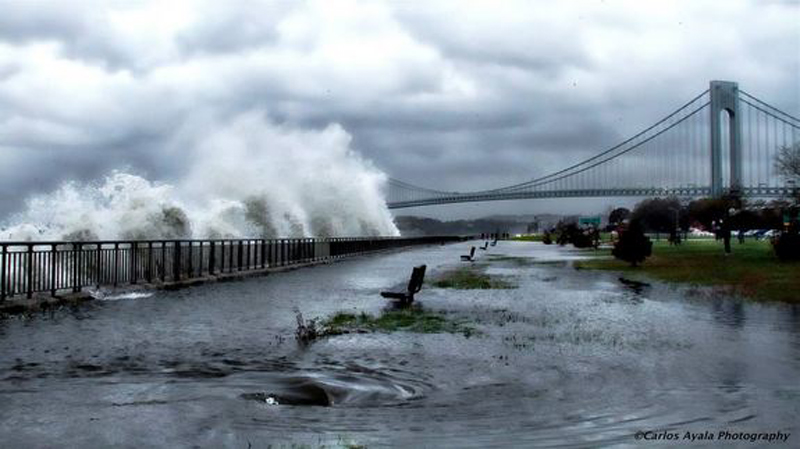Post-Sandy, NYC Will Lead in Climate Change Battle, Mayor Says

Mayor Michael Bloomberg, addressing a meeting on New York City's recovery from Hurricane Sandy this morning, spoke of a future in a warming world with the stark reality of more such devastating storms, saying the city will lead the way in stemming climate change.
"We cannot solve the problems associated with climate change alone here in New York City, but I think it's fair to say we can lead the way," Bloomberg said during his speech, which was broadcast on local news channel NY1.
Hurricane Sandy was a record-breaking storm by many measures, from its tremendous storm surge to its low pressure and strong winds — and potentially in its overall costs.
And while linking any particular storm to climate change is tricky, scientists do say changes in climate will shift the odds toward more extreme weather events. They often use the analogy of loading the die, such that one roll may or may not be the result of a modified die but after many rolls the biased results become clear.
"This was a complex storm, so we do need to be cautious about linking it to climate change," Jonathan Foley, an ecosystem researcher who is director of the University of Minnesota's Institute on the Environment, told LiveScience in November. "Only some of its components may have been due to climate change."
For instance, warmer sea-surface temperatures, which fuel storms like Sandy, along with higher sea levels likely only magnified Hurricane Sandy, according to climate scientist Michael Mann, of Pennsylvania State University. [See Photos of Sandy's Aftermath]
And as Bloomberg pointed out this morning, there was less than a 1 percent chance of Sandy's coastal storm surge that reached 13-14 feet (4 meters), which included storm surge and a high tide, in New York City's Battery Park. It was the highest in at least two centuries, and something that can be attributed to climate change, Mann said in November.
Get the world’s most fascinating discoveries delivered straight to your inbox.
"Someone set the fire with meteorology, but climate change added the fuel," Foley said.
Today, Bloomberg announced he has set in place a team to craft concrete recovery plans for those hit hardest by Sandy and plans for dealing with the risks we face from climate change. "The biggest challenge we face is adapting our city to the risks associated with climate change," Bloomberg said.
As for how he plans to do that, Bloomberg first noted some projects that are already in the works, including restoring 127 acres (51 hectares) of wetlands, which act as natural barriers to storm surge. (Related, 15-foot-high sand dunes built along some of Long Island, proved their worth during Hurricane Sandy, protecting those communities from catastrophic damage that was evident in places on the island without the man-made dunes, reported the New York Times.)
By 2030, Bloomberg said the goal is to reduce the city's carbon footprint, or ultimately the amount of the greenhouse gas carbon dioxide is released into the atmosphere, by 30 percent.
He also mentioned a "green infrastructure" project that would capture rainwater before it floods coastal areas, an expansion of Staten Island's stormwater management system called Bluebelt, as well as some zoning changes for coastal building.
A new recycling center being built in Brooklyn's coastal Red Hook neighbourhood is an example of what these zoning changes can do: The center is elevated above the flood plain and escaped any significant damage from the storm surge.
"We can't just rebuild what was there and hope for the best," Bloomberg said.
Mayor Bloomberg also said that the city was looking at climate change and storm impacts to the city's critical infrastructure, such as its subway system (the largest in the nation), its tunnels and utilities, such as electricity and cellphone towers.
"We have to re-examine all of our major infrastructure in light of Sandy," Bloomberg said.
Follow LiveScience on Twitter @livescience. We're also on Facebook &Google+.
Jeanna Bryner is managing editor of Scientific American. Previously she was editor in chief of Live Science and, prior to that, an editor at Scholastic's Science World magazine. Bryner has an English degree from Salisbury University, a master's degree in biogeochemistry and environmental sciences from the University of Maryland and a graduate science journalism degree from New York University. She has worked as a biologist in Florida, where she monitored wetlands and did field surveys for endangered species, including the gorgeous Florida Scrub Jay. She also received an ocean sciences journalism fellowship from the Woods Hole Oceanographic Institution. She is a firm believer that science is for everyone and that just about everything can be viewed through the lens of science.


